HNN217 - Socially Inclusive Nursing to Promote Equitable Health
VerifiedAdded on 2023/04/23
|8
|2455
|182
Essay
AI Summary
This essay examines the critical role of socially inclusive nursing practices in promoting health equity for Aboriginal and Torres Strait Islander peoples in Australia. It highlights the significant health disparities between indigenous and non-indigenous populations, attributing them to socio-economic factors, discrimination, and limited access to quality healthcare. The essay emphasizes the importance of culturally sensitive and community-based nursing interventions, including health education, disease prevention, and advocacy. It further discusses the need for nurses to possess strong communication skills, cultural competence, and critical thinking abilities to effectively address the unique healthcare needs of indigenous communities. Governmental initiatives like the Indigenous Australians’ Health Program (IAHP) are mentioned, along with the strategy of community engagement, to improve healthcare access and outcomes. The essay concludes by stressing that reducing health inequality requires a multi-faceted approach that involves government support, culturally appropriate healthcare practices, and a commitment from nurses and other healthcare professionals to serve indigenous communities with respect and understanding. Desklib offers a range of resources, including past papers and solved assignments, to support students in their studies.
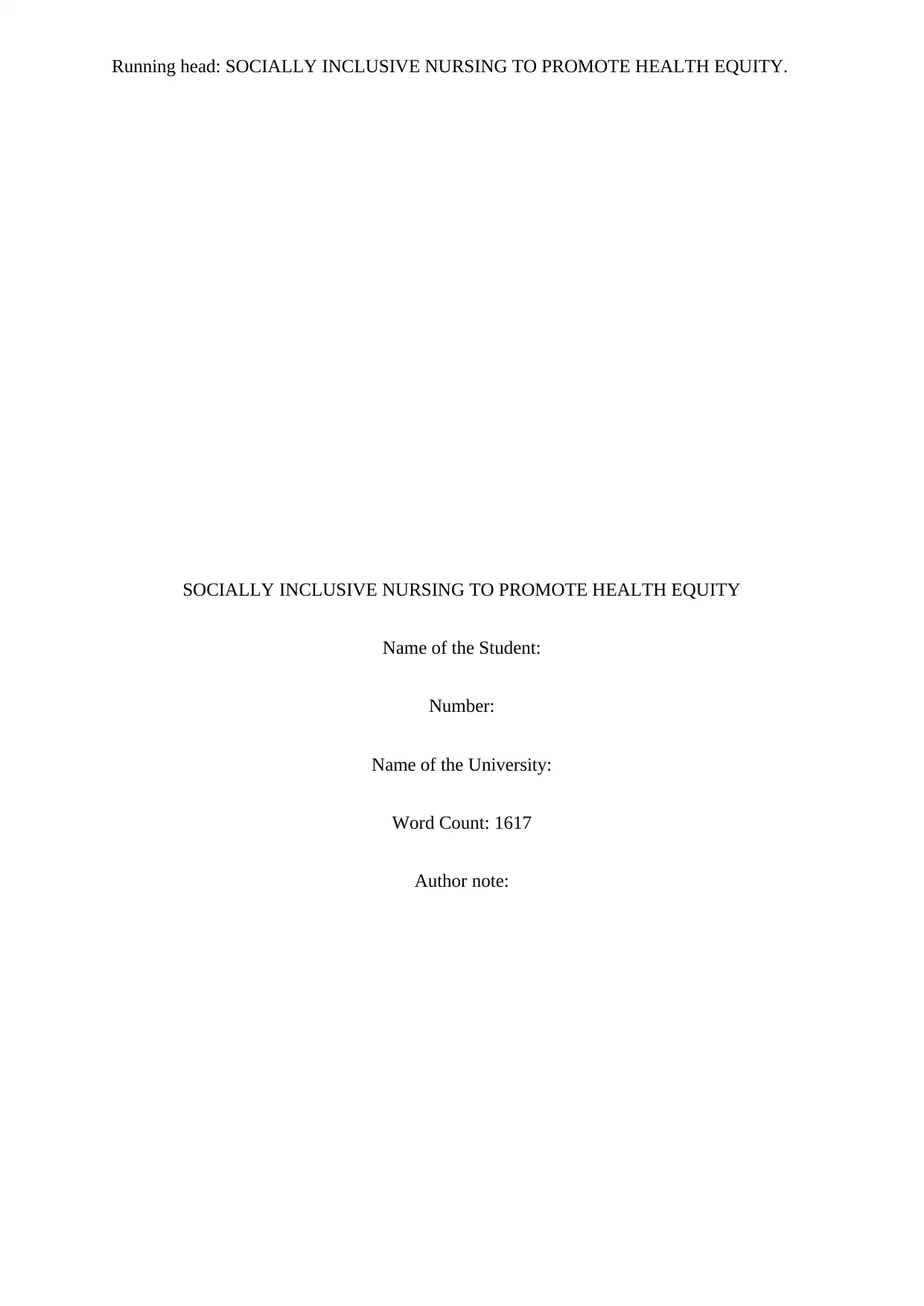
Running head: SOCIALLY INCLUSIVE NURSING TO PROMOTE HEALTH EQUITY.
SOCIALLY INCLUSIVE NURSING TO PROMOTE HEALTH EQUITY
Name of the Student:
Number:
Name of the University:
Word Count: 1617
Author note:
SOCIALLY INCLUSIVE NURSING TO PROMOTE HEALTH EQUITY
Name of the Student:
Number:
Name of the University:
Word Count: 1617
Author note:
Paraphrase This Document
Need a fresh take? Get an instant paraphrase of this document with our AI Paraphraser
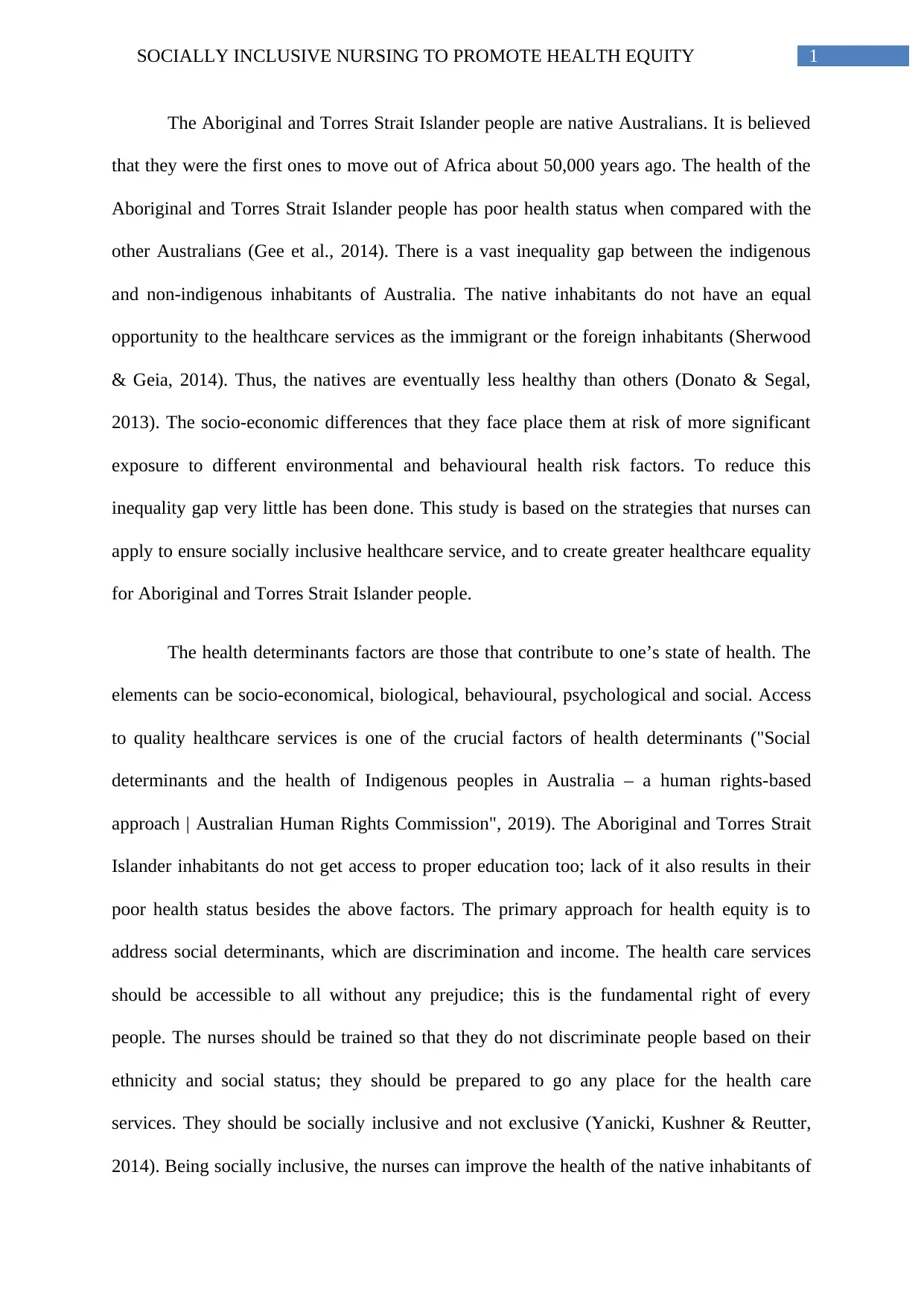
1SOCIALLY INCLUSIVE NURSING TO PROMOTE HEALTH EQUITY
The Aboriginal and Torres Strait Islander people are native Australians. It is believed
that they were the first ones to move out of Africa about 50,000 years ago. The health of the
Aboriginal and Torres Strait Islander people has poor health status when compared with the
other Australians (Gee et al., 2014). There is a vast inequality gap between the indigenous
and non-indigenous inhabitants of Australia. The native inhabitants do not have an equal
opportunity to the healthcare services as the immigrant or the foreign inhabitants (Sherwood
& Geia, 2014). Thus, the natives are eventually less healthy than others (Donato & Segal,
2013). The socio-economic differences that they face place them at risk of more significant
exposure to different environmental and behavioural health risk factors. To reduce this
inequality gap very little has been done. This study is based on the strategies that nurses can
apply to ensure socially inclusive healthcare service, and to create greater healthcare equality
for Aboriginal and Torres Strait Islander people.
The health determinants factors are those that contribute to one’s state of health. The
elements can be socio-economical, biological, behavioural, psychological and social. Access
to quality healthcare services is one of the crucial factors of health determinants ("Social
determinants and the health of Indigenous peoples in Australia – a human rights-based
approach | Australian Human Rights Commission", 2019). The Aboriginal and Torres Strait
Islander inhabitants do not get access to proper education too; lack of it also results in their
poor health status besides the above factors. The primary approach for health equity is to
address social determinants, which are discrimination and income. The health care services
should be accessible to all without any prejudice; this is the fundamental right of every
people. The nurses should be trained so that they do not discriminate people based on their
ethnicity and social status; they should be prepared to go any place for the health care
services. They should be socially inclusive and not exclusive (Yanicki, Kushner & Reutter,
2014). Being socially inclusive, the nurses can improve the health of the native inhabitants of
The Aboriginal and Torres Strait Islander people are native Australians. It is believed
that they were the first ones to move out of Africa about 50,000 years ago. The health of the
Aboriginal and Torres Strait Islander people has poor health status when compared with the
other Australians (Gee et al., 2014). There is a vast inequality gap between the indigenous
and non-indigenous inhabitants of Australia. The native inhabitants do not have an equal
opportunity to the healthcare services as the immigrant or the foreign inhabitants (Sherwood
& Geia, 2014). Thus, the natives are eventually less healthy than others (Donato & Segal,
2013). The socio-economic differences that they face place them at risk of more significant
exposure to different environmental and behavioural health risk factors. To reduce this
inequality gap very little has been done. This study is based on the strategies that nurses can
apply to ensure socially inclusive healthcare service, and to create greater healthcare equality
for Aboriginal and Torres Strait Islander people.
The health determinants factors are those that contribute to one’s state of health. The
elements can be socio-economical, biological, behavioural, psychological and social. Access
to quality healthcare services is one of the crucial factors of health determinants ("Social
determinants and the health of Indigenous peoples in Australia – a human rights-based
approach | Australian Human Rights Commission", 2019). The Aboriginal and Torres Strait
Islander inhabitants do not get access to proper education too; lack of it also results in their
poor health status besides the above factors. The primary approach for health equity is to
address social determinants, which are discrimination and income. The health care services
should be accessible to all without any prejudice; this is the fundamental right of every
people. The nurses should be trained so that they do not discriminate people based on their
ethnicity and social status; they should be prepared to go any place for the health care
services. They should be socially inclusive and not exclusive (Yanicki, Kushner & Reutter,
2014). Being socially inclusive, the nurses can improve the health of the native inhabitants of
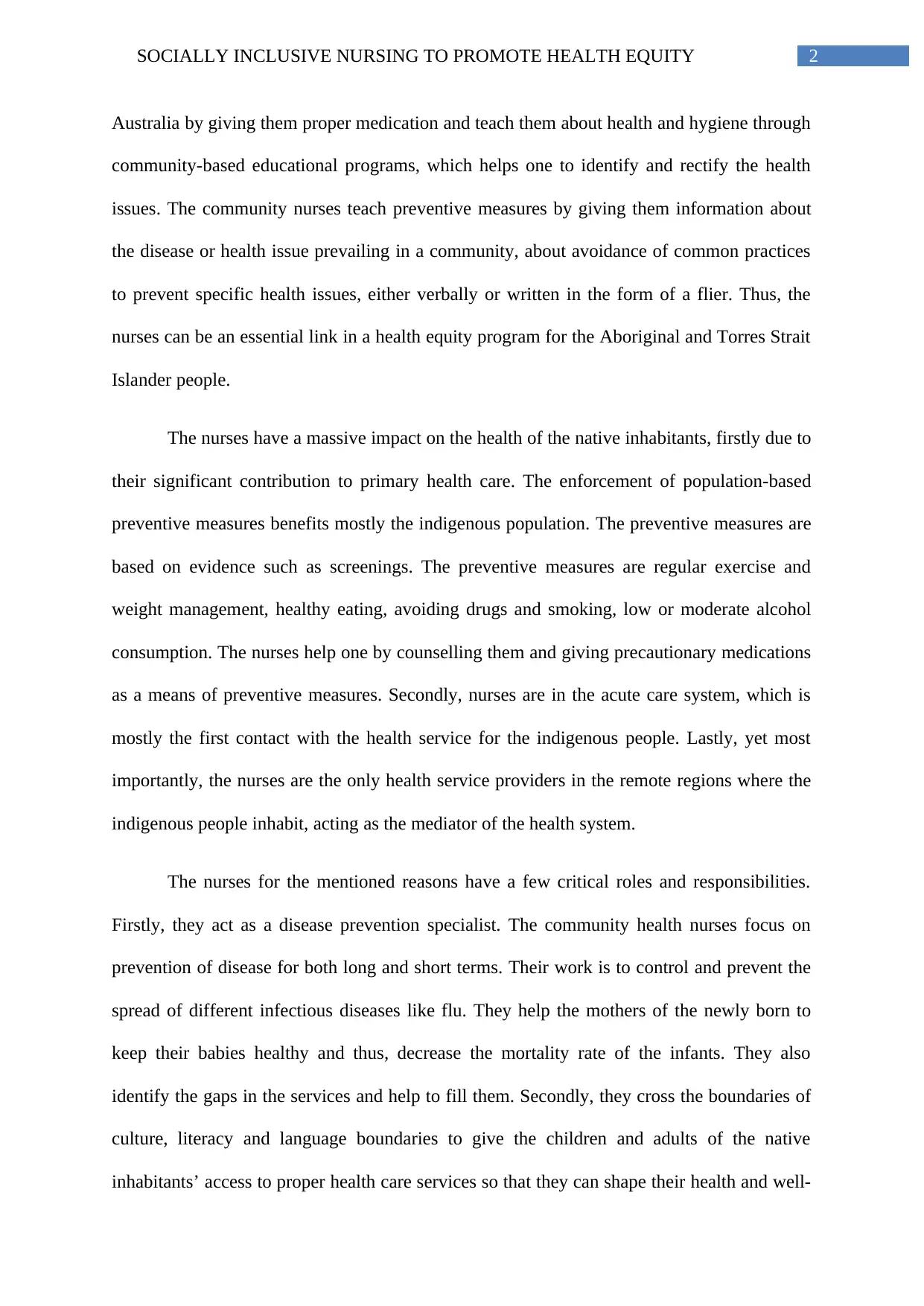
2SOCIALLY INCLUSIVE NURSING TO PROMOTE HEALTH EQUITY
Australia by giving them proper medication and teach them about health and hygiene through
community-based educational programs, which helps one to identify and rectify the health
issues. The community nurses teach preventive measures by giving them information about
the disease or health issue prevailing in a community, about avoidance of common practices
to prevent specific health issues, either verbally or written in the form of a flier. Thus, the
nurses can be an essential link in a health equity program for the Aboriginal and Torres Strait
Islander people.
The nurses have a massive impact on the health of the native inhabitants, firstly due to
their significant contribution to primary health care. The enforcement of population-based
preventive measures benefits mostly the indigenous population. The preventive measures are
based on evidence such as screenings. The preventive measures are regular exercise and
weight management, healthy eating, avoiding drugs and smoking, low or moderate alcohol
consumption. The nurses help one by counselling them and giving precautionary medications
as a means of preventive measures. Secondly, nurses are in the acute care system, which is
mostly the first contact with the health service for the indigenous people. Lastly, yet most
importantly, the nurses are the only health service providers in the remote regions where the
indigenous people inhabit, acting as the mediator of the health system.
The nurses for the mentioned reasons have a few critical roles and responsibilities.
Firstly, they act as a disease prevention specialist. The community health nurses focus on
prevention of disease for both long and short terms. Their work is to control and prevent the
spread of different infectious diseases like flu. They help the mothers of the newly born to
keep their babies healthy and thus, decrease the mortality rate of the infants. They also
identify the gaps in the services and help to fill them. Secondly, they cross the boundaries of
culture, literacy and language boundaries to give the children and adults of the native
inhabitants’ access to proper health care services so that they can shape their health and well-
Australia by giving them proper medication and teach them about health and hygiene through
community-based educational programs, which helps one to identify and rectify the health
issues. The community nurses teach preventive measures by giving them information about
the disease or health issue prevailing in a community, about avoidance of common practices
to prevent specific health issues, either verbally or written in the form of a flier. Thus, the
nurses can be an essential link in a health equity program for the Aboriginal and Torres Strait
Islander people.
The nurses have a massive impact on the health of the native inhabitants, firstly due to
their significant contribution to primary health care. The enforcement of population-based
preventive measures benefits mostly the indigenous population. The preventive measures are
based on evidence such as screenings. The preventive measures are regular exercise and
weight management, healthy eating, avoiding drugs and smoking, low or moderate alcohol
consumption. The nurses help one by counselling them and giving precautionary medications
as a means of preventive measures. Secondly, nurses are in the acute care system, which is
mostly the first contact with the health service for the indigenous people. Lastly, yet most
importantly, the nurses are the only health service providers in the remote regions where the
indigenous people inhabit, acting as the mediator of the health system.
The nurses for the mentioned reasons have a few critical roles and responsibilities.
Firstly, they act as a disease prevention specialist. The community health nurses focus on
prevention of disease for both long and short terms. Their work is to control and prevent the
spread of different infectious diseases like flu. They help the mothers of the newly born to
keep their babies healthy and thus, decrease the mortality rate of the infants. They also
identify the gaps in the services and help to fill them. Secondly, they cross the boundaries of
culture, literacy and language boundaries to give the children and adults of the native
inhabitants’ access to proper health care services so that they can shape their health and well-
⊘ This is a preview!⊘
Do you want full access?
Subscribe today to unlock all pages.

Trusted by 1+ million students worldwide
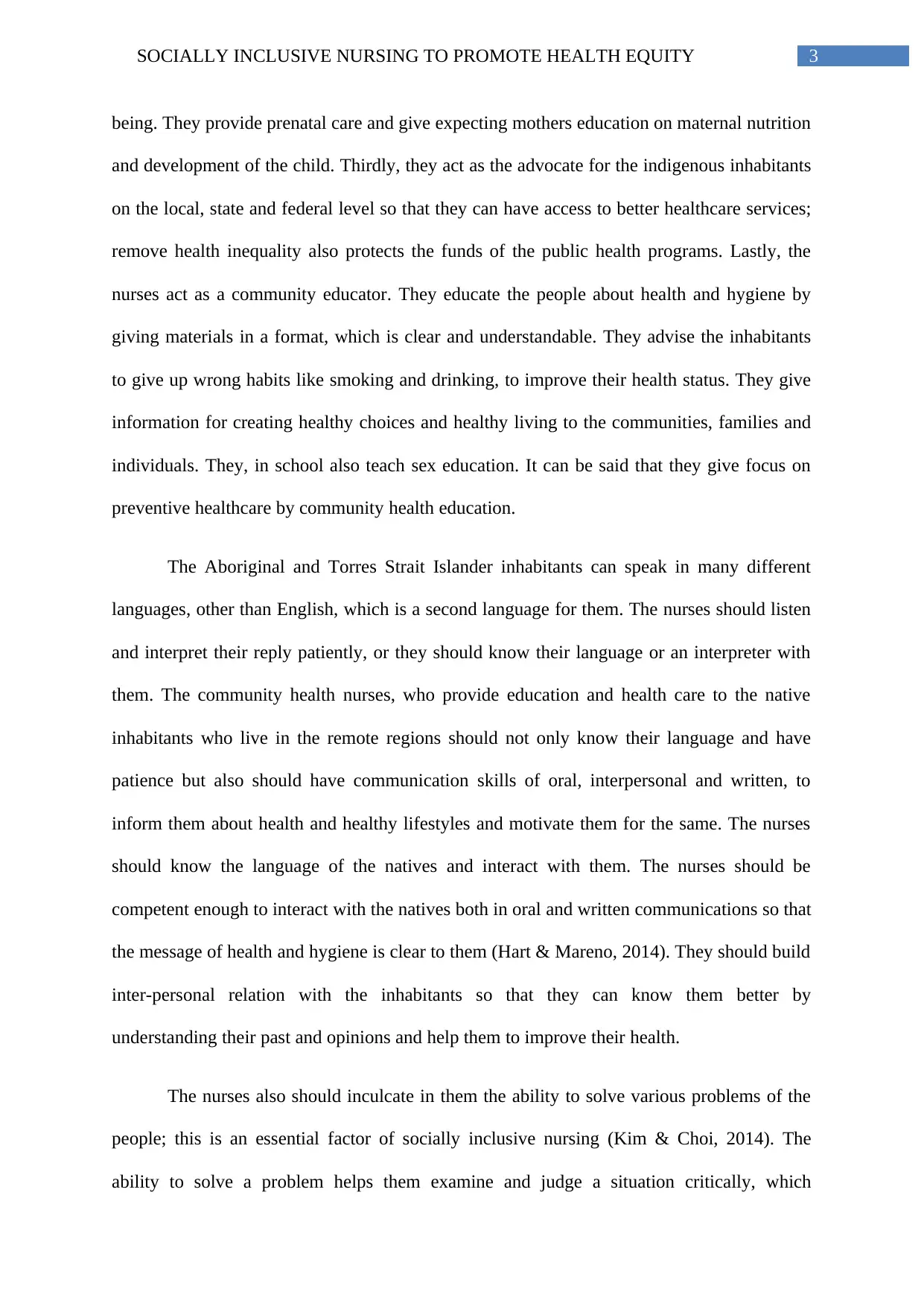
3SOCIALLY INCLUSIVE NURSING TO PROMOTE HEALTH EQUITY
being. They provide prenatal care and give expecting mothers education on maternal nutrition
and development of the child. Thirdly, they act as the advocate for the indigenous inhabitants
on the local, state and federal level so that they can have access to better healthcare services;
remove health inequality also protects the funds of the public health programs. Lastly, the
nurses act as a community educator. They educate the people about health and hygiene by
giving materials in a format, which is clear and understandable. They advise the inhabitants
to give up wrong habits like smoking and drinking, to improve their health status. They give
information for creating healthy choices and healthy living to the communities, families and
individuals. They, in school also teach sex education. It can be said that they give focus on
preventive healthcare by community health education.
The Aboriginal and Torres Strait Islander inhabitants can speak in many different
languages, other than English, which is a second language for them. The nurses should listen
and interpret their reply patiently, or they should know their language or an interpreter with
them. The community health nurses, who provide education and health care to the native
inhabitants who live in the remote regions should not only know their language and have
patience but also should have communication skills of oral, interpersonal and written, to
inform them about health and healthy lifestyles and motivate them for the same. The nurses
should know the language of the natives and interact with them. The nurses should be
competent enough to interact with the natives both in oral and written communications so that
the message of health and hygiene is clear to them (Hart & Mareno, 2014). They should build
inter-personal relation with the inhabitants so that they can know them better by
understanding their past and opinions and help them to improve their health.
The nurses also should inculcate in them the ability to solve various problems of the
people; this is an essential factor of socially inclusive nursing (Kim & Choi, 2014). The
ability to solve a problem helps them examine and judge a situation critically, which
being. They provide prenatal care and give expecting mothers education on maternal nutrition
and development of the child. Thirdly, they act as the advocate for the indigenous inhabitants
on the local, state and federal level so that they can have access to better healthcare services;
remove health inequality also protects the funds of the public health programs. Lastly, the
nurses act as a community educator. They educate the people about health and hygiene by
giving materials in a format, which is clear and understandable. They advise the inhabitants
to give up wrong habits like smoking and drinking, to improve their health status. They give
information for creating healthy choices and healthy living to the communities, families and
individuals. They, in school also teach sex education. It can be said that they give focus on
preventive healthcare by community health education.
The Aboriginal and Torres Strait Islander inhabitants can speak in many different
languages, other than English, which is a second language for them. The nurses should listen
and interpret their reply patiently, or they should know their language or an interpreter with
them. The community health nurses, who provide education and health care to the native
inhabitants who live in the remote regions should not only know their language and have
patience but also should have communication skills of oral, interpersonal and written, to
inform them about health and healthy lifestyles and motivate them for the same. The nurses
should know the language of the natives and interact with them. The nurses should be
competent enough to interact with the natives both in oral and written communications so that
the message of health and hygiene is clear to them (Hart & Mareno, 2014). They should build
inter-personal relation with the inhabitants so that they can know them better by
understanding their past and opinions and help them to improve their health.
The nurses also should inculcate in them the ability to solve various problems of the
people; this is an essential factor of socially inclusive nursing (Kim & Choi, 2014). The
ability to solve a problem helps them examine and judge a situation critically, which
Paraphrase This Document
Need a fresh take? Get an instant paraphrase of this document with our AI Paraphraser
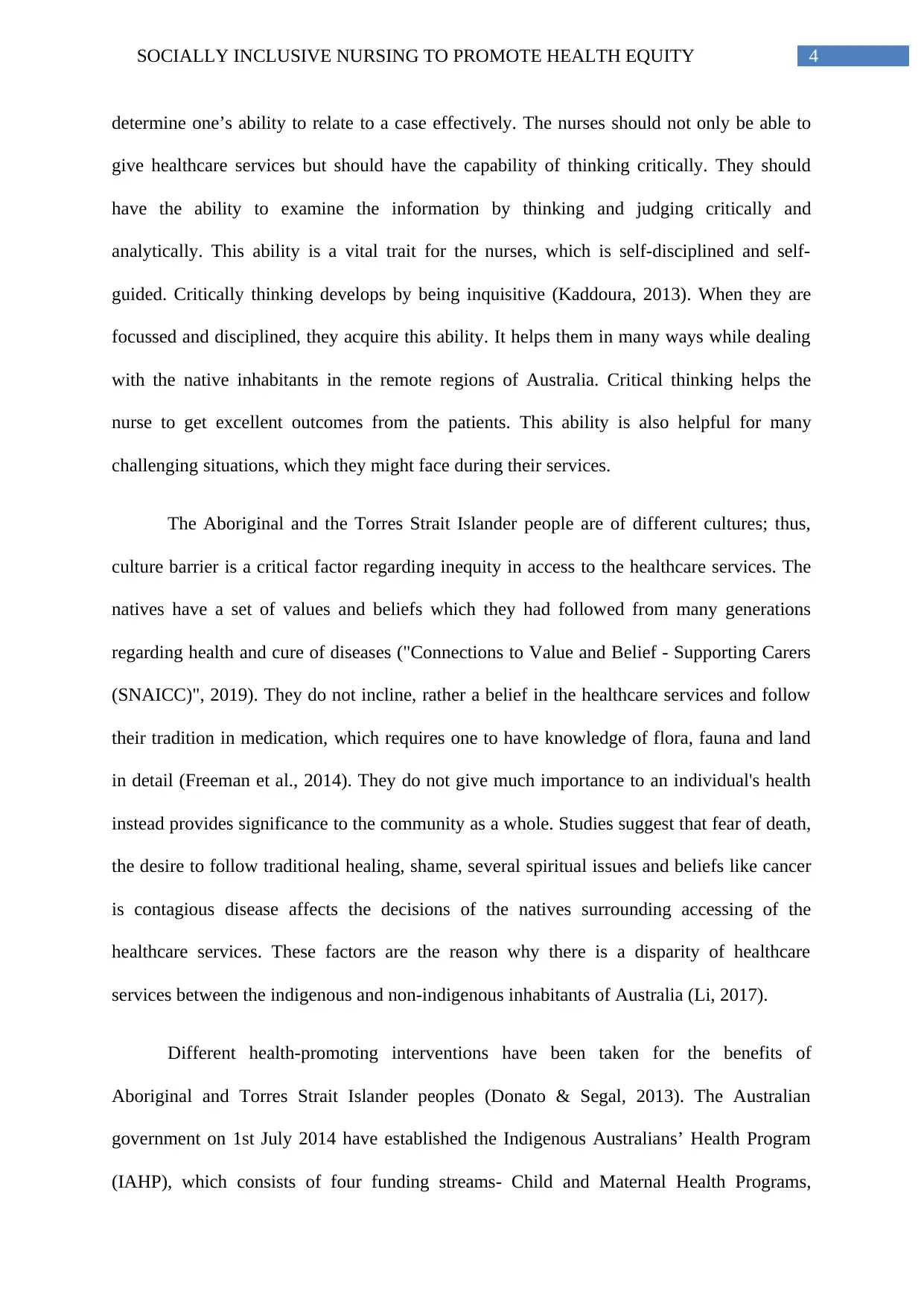
4SOCIALLY INCLUSIVE NURSING TO PROMOTE HEALTH EQUITY
determine one’s ability to relate to a case effectively. The nurses should not only be able to
give healthcare services but should have the capability of thinking critically. They should
have the ability to examine the information by thinking and judging critically and
analytically. This ability is a vital trait for the nurses, which is self-disciplined and self-
guided. Critically thinking develops by being inquisitive (Kaddoura, 2013). When they are
focussed and disciplined, they acquire this ability. It helps them in many ways while dealing
with the native inhabitants in the remote regions of Australia. Critical thinking helps the
nurse to get excellent outcomes from the patients. This ability is also helpful for many
challenging situations, which they might face during their services.
The Aboriginal and the Torres Strait Islander people are of different cultures; thus,
culture barrier is a critical factor regarding inequity in access to the healthcare services. The
natives have a set of values and beliefs which they had followed from many generations
regarding health and cure of diseases ("Connections to Value and Belief - Supporting Carers
(SNAICC)", 2019). They do not incline, rather a belief in the healthcare services and follow
their tradition in medication, which requires one to have knowledge of flora, fauna and land
in detail (Freeman et al., 2014). They do not give much importance to an individual's health
instead provides significance to the community as a whole. Studies suggest that fear of death,
the desire to follow traditional healing, shame, several spiritual issues and beliefs like cancer
is contagious disease affects the decisions of the natives surrounding accessing of the
healthcare services. These factors are the reason why there is a disparity of healthcare
services between the indigenous and non-indigenous inhabitants of Australia (Li, 2017).
Different health-promoting interventions have been taken for the benefits of
Aboriginal and Torres Strait Islander peoples (Donato & Segal, 2013). The Australian
government on 1st July 2014 have established the Indigenous Australians’ Health Program
(IAHP), which consists of four funding streams- Child and Maternal Health Programs,
determine one’s ability to relate to a case effectively. The nurses should not only be able to
give healthcare services but should have the capability of thinking critically. They should
have the ability to examine the information by thinking and judging critically and
analytically. This ability is a vital trait for the nurses, which is self-disciplined and self-
guided. Critically thinking develops by being inquisitive (Kaddoura, 2013). When they are
focussed and disciplined, they acquire this ability. It helps them in many ways while dealing
with the native inhabitants in the remote regions of Australia. Critical thinking helps the
nurse to get excellent outcomes from the patients. This ability is also helpful for many
challenging situations, which they might face during their services.
The Aboriginal and the Torres Strait Islander people are of different cultures; thus,
culture barrier is a critical factor regarding inequity in access to the healthcare services. The
natives have a set of values and beliefs which they had followed from many generations
regarding health and cure of diseases ("Connections to Value and Belief - Supporting Carers
(SNAICC)", 2019). They do not incline, rather a belief in the healthcare services and follow
their tradition in medication, which requires one to have knowledge of flora, fauna and land
in detail (Freeman et al., 2014). They do not give much importance to an individual's health
instead provides significance to the community as a whole. Studies suggest that fear of death,
the desire to follow traditional healing, shame, several spiritual issues and beliefs like cancer
is contagious disease affects the decisions of the natives surrounding accessing of the
healthcare services. These factors are the reason why there is a disparity of healthcare
services between the indigenous and non-indigenous inhabitants of Australia (Li, 2017).
Different health-promoting interventions have been taken for the benefits of
Aboriginal and Torres Strait Islander peoples (Donato & Segal, 2013). The Australian
government on 1st July 2014 have established the Indigenous Australians’ Health Program
(IAHP), which consists of four funding streams- Child and Maternal Health Programs,
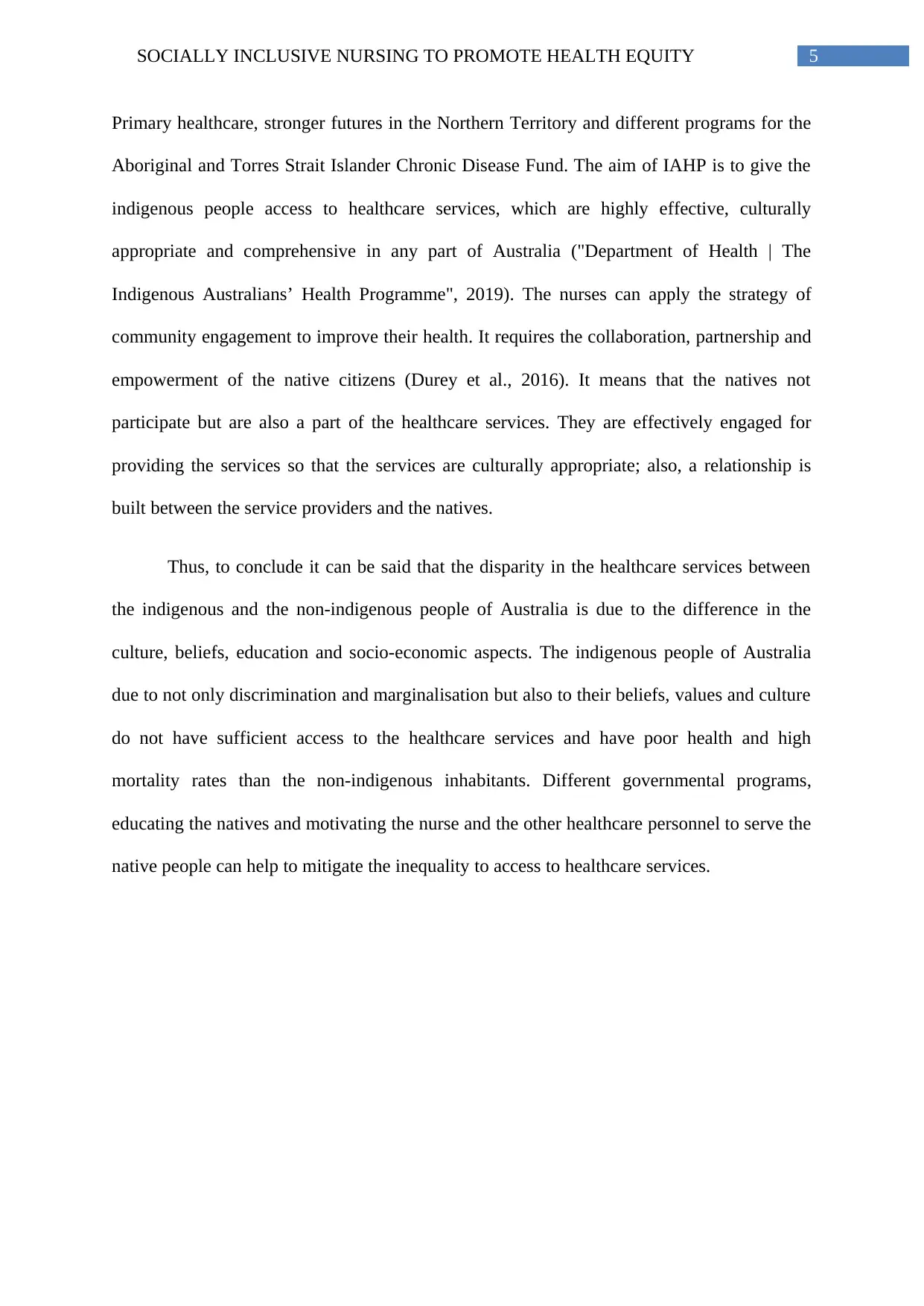
5SOCIALLY INCLUSIVE NURSING TO PROMOTE HEALTH EQUITY
Primary healthcare, stronger futures in the Northern Territory and different programs for the
Aboriginal and Torres Strait Islander Chronic Disease Fund. The aim of IAHP is to give the
indigenous people access to healthcare services, which are highly effective, culturally
appropriate and comprehensive in any part of Australia ("Department of Health | The
Indigenous Australians’ Health Programme", 2019). The nurses can apply the strategy of
community engagement to improve their health. It requires the collaboration, partnership and
empowerment of the native citizens (Durey et al., 2016). It means that the natives not
participate but are also a part of the healthcare services. They are effectively engaged for
providing the services so that the services are culturally appropriate; also, a relationship is
built between the service providers and the natives.
Thus, to conclude it can be said that the disparity in the healthcare services between
the indigenous and the non-indigenous people of Australia is due to the difference in the
culture, beliefs, education and socio-economic aspects. The indigenous people of Australia
due to not only discrimination and marginalisation but also to their beliefs, values and culture
do not have sufficient access to the healthcare services and have poor health and high
mortality rates than the non-indigenous inhabitants. Different governmental programs,
educating the natives and motivating the nurse and the other healthcare personnel to serve the
native people can help to mitigate the inequality to access to healthcare services.
Primary healthcare, stronger futures in the Northern Territory and different programs for the
Aboriginal and Torres Strait Islander Chronic Disease Fund. The aim of IAHP is to give the
indigenous people access to healthcare services, which are highly effective, culturally
appropriate and comprehensive in any part of Australia ("Department of Health | The
Indigenous Australians’ Health Programme", 2019). The nurses can apply the strategy of
community engagement to improve their health. It requires the collaboration, partnership and
empowerment of the native citizens (Durey et al., 2016). It means that the natives not
participate but are also a part of the healthcare services. They are effectively engaged for
providing the services so that the services are culturally appropriate; also, a relationship is
built between the service providers and the natives.
Thus, to conclude it can be said that the disparity in the healthcare services between
the indigenous and the non-indigenous people of Australia is due to the difference in the
culture, beliefs, education and socio-economic aspects. The indigenous people of Australia
due to not only discrimination and marginalisation but also to their beliefs, values and culture
do not have sufficient access to the healthcare services and have poor health and high
mortality rates than the non-indigenous inhabitants. Different governmental programs,
educating the natives and motivating the nurse and the other healthcare personnel to serve the
native people can help to mitigate the inequality to access to healthcare services.
⊘ This is a preview!⊘
Do you want full access?
Subscribe today to unlock all pages.

Trusted by 1+ million students worldwide
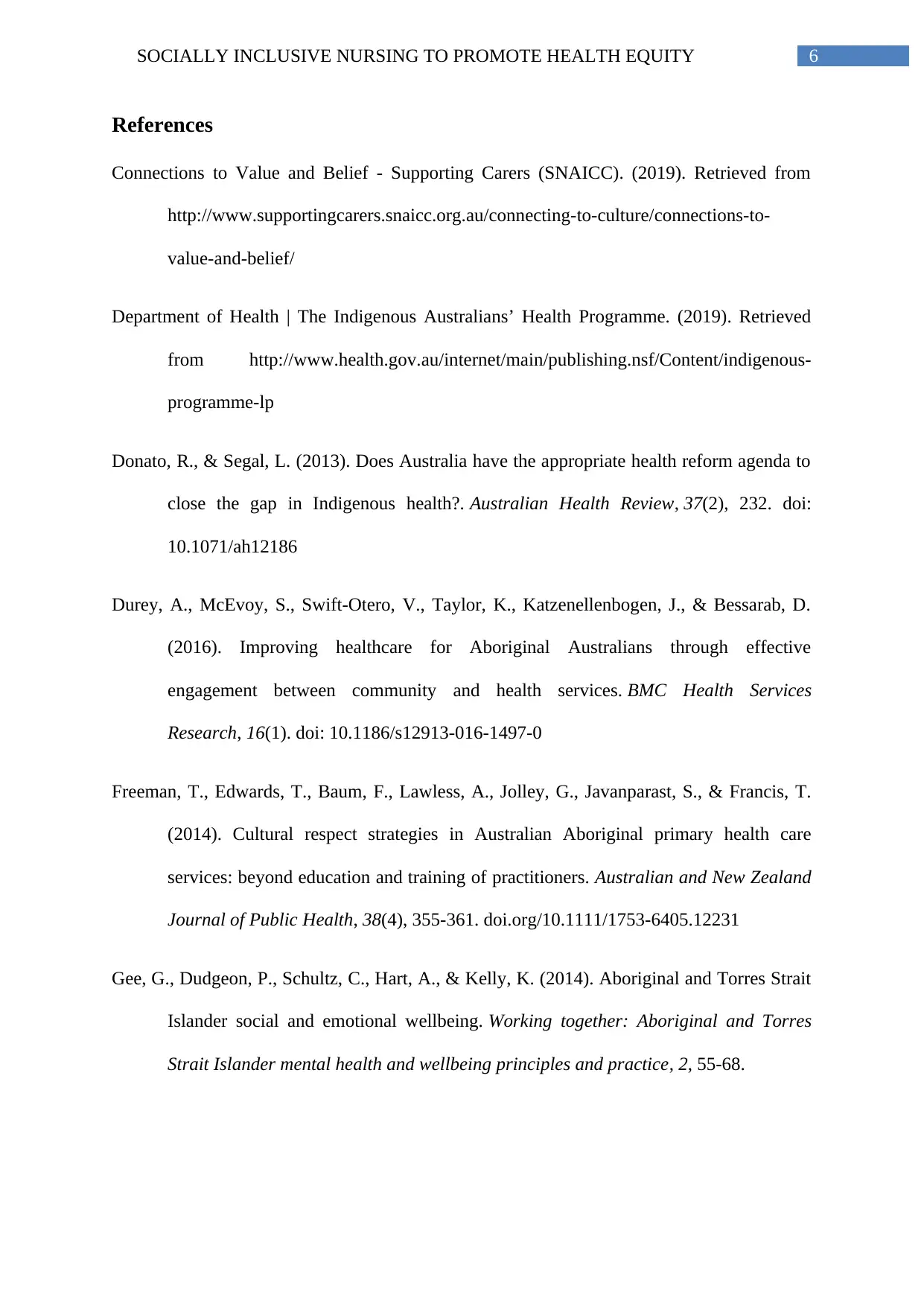
6SOCIALLY INCLUSIVE NURSING TO PROMOTE HEALTH EQUITY
References
Connections to Value and Belief - Supporting Carers (SNAICC). (2019). Retrieved from
http://www.supportingcarers.snaicc.org.au/connecting-to-culture/connections-to-
value-and-belief/
Department of Health | The Indigenous Australians’ Health Programme. (2019). Retrieved
from http://www.health.gov.au/internet/main/publishing.nsf/Content/indigenous-
programme-lp
Donato, R., & Segal, L. (2013). Does Australia have the appropriate health reform agenda to
close the gap in Indigenous health?. Australian Health Review, 37(2), 232. doi:
10.1071/ah12186
Durey, A., McEvoy, S., Swift-Otero, V., Taylor, K., Katzenellenbogen, J., & Bessarab, D.
(2016). Improving healthcare for Aboriginal Australians through effective
engagement between community and health services. BMC Health Services
Research, 16(1). doi: 10.1186/s12913-016-1497-0
Freeman, T., Edwards, T., Baum, F., Lawless, A., Jolley, G., Javanparast, S., & Francis, T.
(2014). Cultural respect strategies in Australian Aboriginal primary health care
services: beyond education and training of practitioners. Australian and New Zealand
Journal of Public Health, 38(4), 355-361. doi.org/10.1111/1753-6405.12231
Gee, G., Dudgeon, P., Schultz, C., Hart, A., & Kelly, K. (2014). Aboriginal and Torres Strait
Islander social and emotional wellbeing. Working together: Aboriginal and Torres
Strait Islander mental health and wellbeing principles and practice, 2, 55-68.
References
Connections to Value and Belief - Supporting Carers (SNAICC). (2019). Retrieved from
http://www.supportingcarers.snaicc.org.au/connecting-to-culture/connections-to-
value-and-belief/
Department of Health | The Indigenous Australians’ Health Programme. (2019). Retrieved
from http://www.health.gov.au/internet/main/publishing.nsf/Content/indigenous-
programme-lp
Donato, R., & Segal, L. (2013). Does Australia have the appropriate health reform agenda to
close the gap in Indigenous health?. Australian Health Review, 37(2), 232. doi:
10.1071/ah12186
Durey, A., McEvoy, S., Swift-Otero, V., Taylor, K., Katzenellenbogen, J., & Bessarab, D.
(2016). Improving healthcare for Aboriginal Australians through effective
engagement between community and health services. BMC Health Services
Research, 16(1). doi: 10.1186/s12913-016-1497-0
Freeman, T., Edwards, T., Baum, F., Lawless, A., Jolley, G., Javanparast, S., & Francis, T.
(2014). Cultural respect strategies in Australian Aboriginal primary health care
services: beyond education and training of practitioners. Australian and New Zealand
Journal of Public Health, 38(4), 355-361. doi.org/10.1111/1753-6405.12231
Gee, G., Dudgeon, P., Schultz, C., Hart, A., & Kelly, K. (2014). Aboriginal and Torres Strait
Islander social and emotional wellbeing. Working together: Aboriginal and Torres
Strait Islander mental health and wellbeing principles and practice, 2, 55-68.
Paraphrase This Document
Need a fresh take? Get an instant paraphrase of this document with our AI Paraphraser
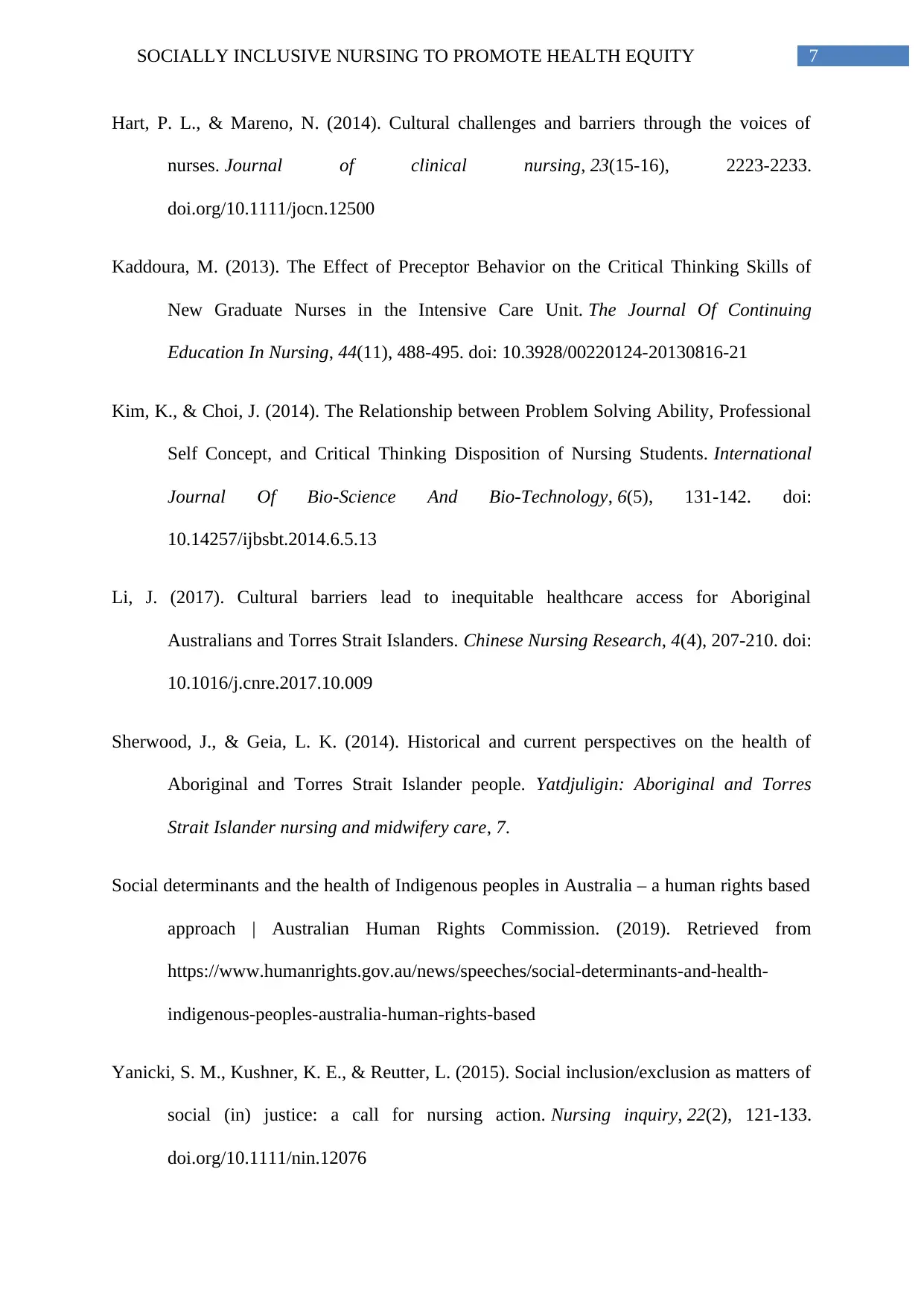
7SOCIALLY INCLUSIVE NURSING TO PROMOTE HEALTH EQUITY
Hart, P. L., & Mareno, N. (2014). Cultural challenges and barriers through the voices of
nurses. Journal of clinical nursing, 23(15-16), 2223-2233.
doi.org/10.1111/jocn.12500
Kaddoura, M. (2013). The Effect of Preceptor Behavior on the Critical Thinking Skills of
New Graduate Nurses in the Intensive Care Unit. The Journal Of Continuing
Education In Nursing, 44(11), 488-495. doi: 10.3928/00220124-20130816-21
Kim, K., & Choi, J. (2014). The Relationship between Problem Solving Ability, Professional
Self Concept, and Critical Thinking Disposition of Nursing Students. International
Journal Of Bio-Science And Bio-Technology, 6(5), 131-142. doi:
10.14257/ijbsbt.2014.6.5.13
Li, J. (2017). Cultural barriers lead to inequitable healthcare access for Aboriginal
Australians and Torres Strait Islanders. Chinese Nursing Research, 4(4), 207-210. doi:
10.1016/j.cnre.2017.10.009
Sherwood, J., & Geia, L. K. (2014). Historical and current perspectives on the health of
Aboriginal and Torres Strait Islander people. Yatdjuligin: Aboriginal and Torres
Strait Islander nursing and midwifery care, 7.
Social determinants and the health of Indigenous peoples in Australia – a human rights based
approach | Australian Human Rights Commission. (2019). Retrieved from
https://www.humanrights.gov.au/news/speeches/social-determinants-and-health-
indigenous-peoples-australia-human-rights-based
Yanicki, S. M., Kushner, K. E., & Reutter, L. (2015). Social inclusion/exclusion as matters of
social (in) justice: a call for nursing action. Nursing inquiry, 22(2), 121-133.
doi.org/10.1111/nin.12076
Hart, P. L., & Mareno, N. (2014). Cultural challenges and barriers through the voices of
nurses. Journal of clinical nursing, 23(15-16), 2223-2233.
doi.org/10.1111/jocn.12500
Kaddoura, M. (2013). The Effect of Preceptor Behavior on the Critical Thinking Skills of
New Graduate Nurses in the Intensive Care Unit. The Journal Of Continuing
Education In Nursing, 44(11), 488-495. doi: 10.3928/00220124-20130816-21
Kim, K., & Choi, J. (2014). The Relationship between Problem Solving Ability, Professional
Self Concept, and Critical Thinking Disposition of Nursing Students. International
Journal Of Bio-Science And Bio-Technology, 6(5), 131-142. doi:
10.14257/ijbsbt.2014.6.5.13
Li, J. (2017). Cultural barriers lead to inequitable healthcare access for Aboriginal
Australians and Torres Strait Islanders. Chinese Nursing Research, 4(4), 207-210. doi:
10.1016/j.cnre.2017.10.009
Sherwood, J., & Geia, L. K. (2014). Historical and current perspectives on the health of
Aboriginal and Torres Strait Islander people. Yatdjuligin: Aboriginal and Torres
Strait Islander nursing and midwifery care, 7.
Social determinants and the health of Indigenous peoples in Australia – a human rights based
approach | Australian Human Rights Commission. (2019). Retrieved from
https://www.humanrights.gov.au/news/speeches/social-determinants-and-health-
indigenous-peoples-australia-human-rights-based
Yanicki, S. M., Kushner, K. E., & Reutter, L. (2015). Social inclusion/exclusion as matters of
social (in) justice: a call for nursing action. Nursing inquiry, 22(2), 121-133.
doi.org/10.1111/nin.12076
1 out of 8
Related Documents
Your All-in-One AI-Powered Toolkit for Academic Success.
+13062052269
info@desklib.com
Available 24*7 on WhatsApp / Email
![[object Object]](/_next/static/media/star-bottom.7253800d.svg)
Unlock your academic potential
Copyright © 2020–2025 A2Z Services. All Rights Reserved. Developed and managed by ZUCOL.





